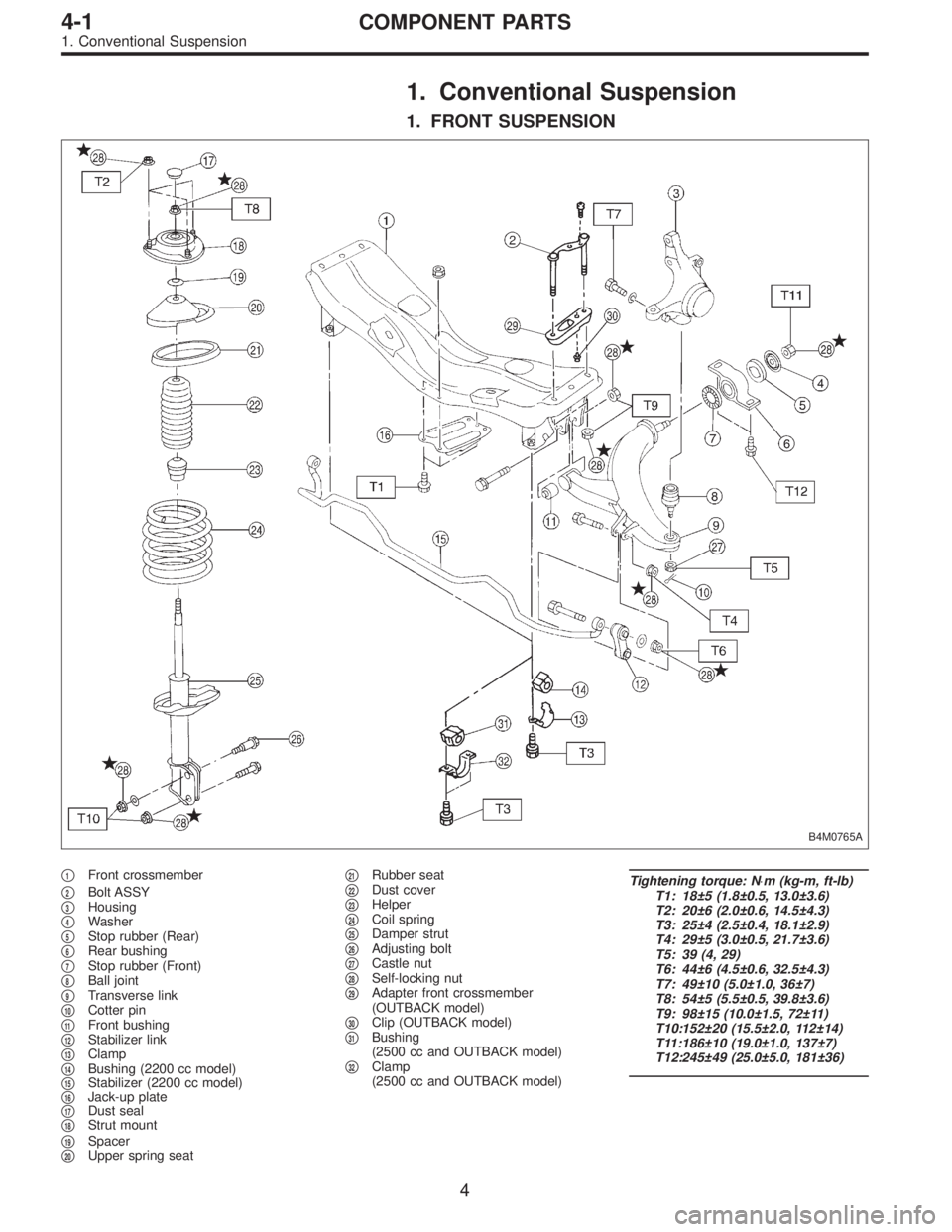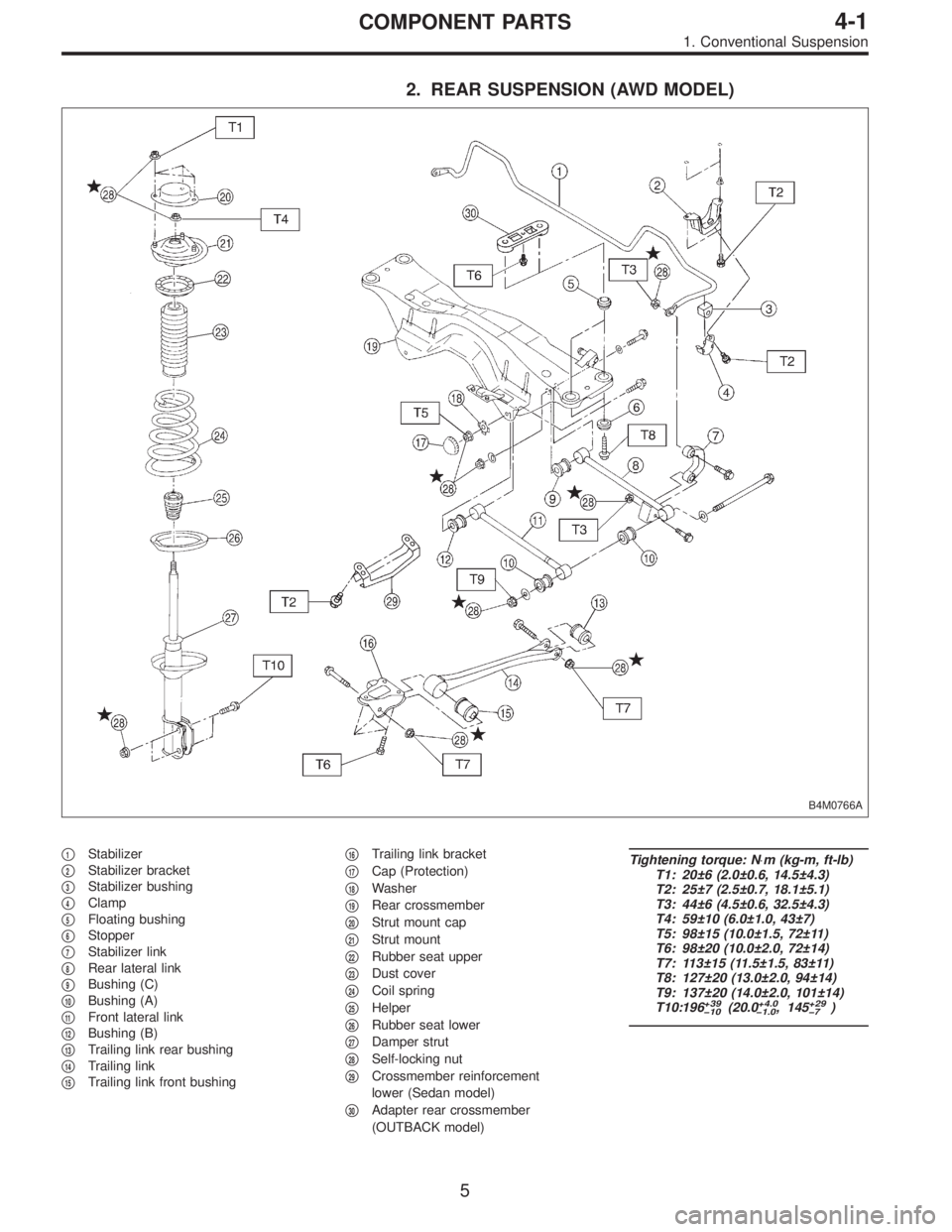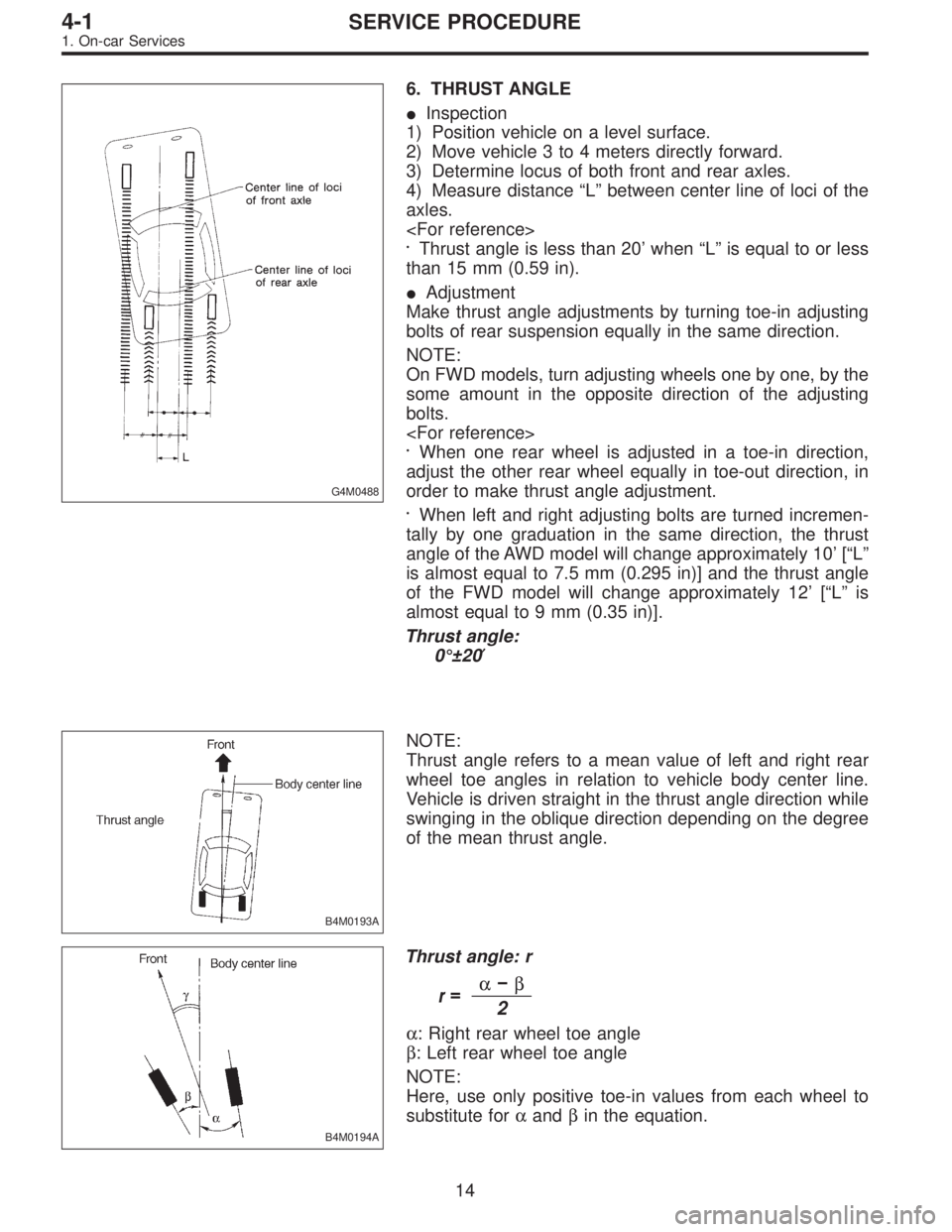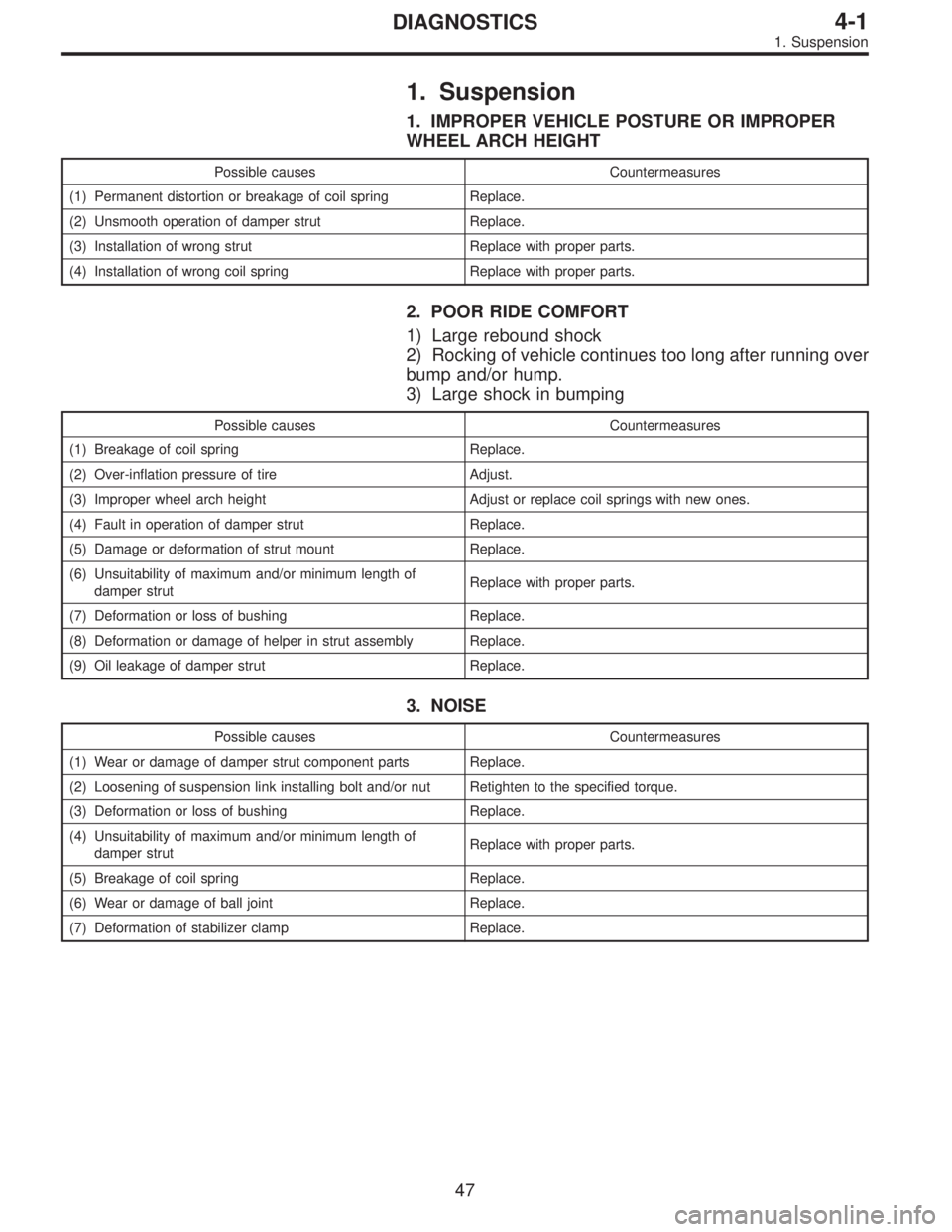Page 1003 of 2890
1. Suspension
A: SPECIFICATIONS
1. STABILIZER
ModelBar dia. mm (in)
Front Rear
Sedan2200 cc 19 (0.75) 15 (0.59)
2500 cc 20 (0.79) 16 (0.63)
Wagon2200 cc 19 (0.75) 15 (0.59)
2500 cc 20 (0.79) 16 (0.63)
OUTBACK2200 cc 20 (0.79) 18 (0.71)
2500 cc 20 (0.79) 18 (0.71)
B: WHEEL ALIGNMENT
Sedan Wagon OUTBACK
FWD AWD FWD AWD AWD
FrontCamber
(tolerance: ±0°30′)�0°05′�0°05′�0°05′�0°05′0°20′
Caster
(tolerance: ±1°)3°05′3°05′3°05′3°05′2°50′
Toe-in mm (in) 0±3 (0±0.12) Total toe angle: 0°±20′
Kingpin angle (tolerance: ±1°) 14°15′14°15′14°15′14°15′13°30′
Wheel arch height
[tolerance:
+12
�24mm (+0.47
� 0.94in)] mm (in)385 (15.16) 385 (15.16) 385 (15.16) 385 (15.16) 420 (16.54)
RearCamber
(tolerance: ±0°45′)�0°55′�1° �0°45′�0°55′�0°35′
Toe-in mm (in) 0±3 (0±0.12) Total toe angle: 0°±20′
Wheel arch height
[tolerance:
+12
�24mm (+0.47
� 0.94in)] mm (in)369 (14.53) 369 (14.53) 379 (14.92) 379 (14.92) 419 (16.50)
Thrust angle 0°±20′
2
4-1SPECIFICATIONS AND SERVICE DATA
1. Suspension
Page 1004 of 2890
B4M0182A
NOTE:
�Front and rear toe-ins and front camber can be adjusted.
If toe-in or front camber tolerance exceeds specifications,
adjust toe-in and camber to the specification.
�The other items indicated in the specification table can-
not be adjusted. If the other items exceeds specifications,
check suspension parts and joint portions of body suspen-
sion parts for deformities; and replace with new ones as
required.
3
4-1SPECIFICATIONS AND SERVICE DATA
1. Suspension
Page 1005 of 2890

1. Conventional Suspension
1. FRONT SUSPENSION
B4M0765A
�1Front crossmember
�
2Bolt ASSY
�3Housing
�4Washer
�5Stop rubber (Rear)
�6Rear bushing
�7Stop rubber (Front)
�8Ball joint
�9Transverse link
�10Cotter pin
�11Front bushing
�12Stabilizer link
�13Clamp
�14Bushing (2200 cc model)
�15Stabilizer (2200 cc model)
�16Jack-up plate
�17Dust seal
�18Strut mount
�
19Spacer
�20Upper spring seat�
21Rubber seat
�22Dust cover
�23Helper
�24Coil spring
�25Damper strut
�26Adjusting bolt
�27Castle nut
�28Self-locking nut
�29Adapter front crossmember
(OUTBACK model)
�
30Clip (OUTBACK model)
�31Bushing
(2500 cc and OUTBACK model)
�
32Clamp
(2500 cc and OUTBACK model)
Tightening torque: N⋅m (kg-m, ft-lb)
T1: 18±5 (1.8±0.5, 13.0±3.6)
T2: 20±6 (2.0±0.6, 14.5±4.3)
T3: 25±4 (2.5±0.4, 18.1±2.9)
T4: 29±5 (3.0±0.5, 21.7±3.6)
T5: 39 (4, 29)
T6: 44±6 (4.5±0.6, 32.5±4.3)
T7: 49±10 (5.0±1.0, 36±7)
T8: 54±5 (5.5±0.5, 39.8±3.6)
T9: 98±15 (10.0±1.5, 72±11)
T10:152±20 (15.5±2.0, 112±14)
T11:186±10 (19.0±1.0, 137±7)
T12:245±49 (25.0±5.0, 181±36)
4
4-1COMPONENT PARTS
1. Conventional Suspension
Page 1006 of 2890

2. REAR SUSPENSION (AWD MODEL)
B4M0766A
�1Stabilizer
�
2Stabilizer bracket
�
3Stabilizer bushing
�
4Clamp
�
5Floating bushing
�
6Stopper
�
7Stabilizer link
�
8Rear lateral link
�
9Bushing (C)
�
10Bushing (A)
�
11Front lateral link
�
12Bushing (B)
�
13Trailing link rear bushing
�
14Trailing link
�
15Trailing link front bushing�
16Trailing link bracket
�
17Cap (Protection)
�
18Washer
�
19Rear crossmember
�
20Strut mount cap
�
21Strut mount
�
22Rubber seat upper
�
23Dust cover
�
24Coil spring
�
25Helper
�
26Rubber seat lower
�
27Damper strut
�
28Self-locking nut
�
29Crossmember reinforcement
lower (Sedan model)
�
30Adapter rear crossmember
(OUTBACK model)
Tightening torque: N⋅m (kg-m, ft-lb)
T1: 20±6 (2.0±0.6, 14.5±4.3)
T2: 25±7 (2.5±0.7, 18.1±5.1)
T3: 44±6 (4.5±0.6, 32.5±4.3)
T4: 59±10 (6.0±1.0, 43±7)
T5: 98±15 (10.0±1.5, 72±11)
T6: 98±20 (10.0±2.0, 72±14)
T7: 113±15 (11.5±1.5, 83±11)
T8: 127±20 (13.0±2.0, 94±14)
T9: 137±20 (14.0±2.0, 101±14)
T10:196
+39
�10(20.0+4.0
�1.0, 145+29
�7)
5
4-1COMPONENT PARTS
1. Conventional Suspension
Page 1007 of 2890
3. REAR SUSPENSION (FWD MODEL)
B4M0185A
�1Stabilizer
�
2Stabilizer bracket
�
3Stabilizer bushing
�
4Clamp
�
5Stabilizer link
�
6Adjusting bolt
�
7Adjusting wheel
�
8Rear lateral link
�
9Bushing (D)
�
10Bushing (A)
�
11Front lateral link
�
12Self-locking nut
�
13Washer
�
14Cap (Protection)�
15Trailing link rear bushing
�
16Trailing link
�
17Trailing link front bushing
�
18Trailing link bracket
�
19Crossmember
�
20Strut mount cap
�
21Strut mount
�
22Rubber seat upper
�
23Dust cover
�
24Coil spring
�
25Helper
�
26Rubber seat lower
�
27Damper strut
Tightening torque: N⋅m (kg-m, ft-lb)
T1: 20±6 (2.0±0.6, 14.5±4.3)
T2: 25±7 (2.5±0.7, 18.1±5.1)
T3: 44±6 (4.5±0.6, 32.5±4.3)
T4: 59±10 (6.0±1.0, 43±7)
T5: 98±20 (10.0±2.0, 72±14)
T6: 113±15 (11.5±1.5, 83±11)
T7: 127±20 (13.0±2.0, 94±14)
T8: 137±20 (14.0±2.0, 101±14)
T9: 196
+39
�10(20.0+4.0
�1.0, 145+29
�7)
6
4-1COMPONENT PARTS
1. Conventional Suspension
Page 1015 of 2890

G4M0488
6. THRUST ANGLE
�Inspection
1) Position vehicle on a level surface.
2) Move vehicle 3 to 4 meters directly forward.
3) Determine locus of both front and rear axles.
4) Measure distance“L”between center line of loci of the
axles.
Thrust angle is less than 20’when“L”is equal to or less
than 15 mm (0.59 in).
�Adjustment
Make thrust angle adjustments by turning toe-in adjusting
bolts of rear suspension equally in the same direction.
NOTE:
On FWD models, turn adjusting wheels one by one, by the
some amount in the opposite direction of the adjusting
bolts.
When one rear wheel is adjusted in a toe-in direction,
adjust the other rear wheel equally in toe-out direction, in
order to make thrust angle adjustment.
When left and right adjusting bolts are turned incremen-
tally by one graduation in the same direction, the thrust
angle of the AWD model will change approximately 10’[“L”
is almost equal to 7.5 mm (0.295 in)] and the thrust angle
of the FWD model will change approximately 12’[“L”is
almost equal to 9 mm (0.35 in)].
Thrust angle:
0°±20′
B4M0193A
NOTE:
Thrust angle refers to a mean value of left and right rear
wheel toe angles in relation to vehicle body center line.
Vehicle is driven straight in the thrust angle direction while
swinging in the oblique direction depending on the degree
of the mean thrust angle.
B4M0194A
Thrust angle: r
r=α�β2
α: Right rear wheel toe angle
β: Left rear wheel toe angle
NOTE:
Here, use only positive toe-in values from each wheel to
substitute forαandβin the equation.
14
4-1SERVICE PROCEDURE
1. On-car Services
Page 1048 of 2890

1. Suspension
1. IMPROPER VEHICLE POSTURE OR IMPROPER
WHEEL ARCH HEIGHT
Possible causes Countermeasures
(1) Permanent distortion or breakage of coil spring Replace.
(2) Unsmooth operation of damper strut Replace.
(3) Installation of wrong strut Replace with proper parts.
(4) Installation of wrong coil spring Replace with proper parts.
2. POOR RIDE COMFORT
1) Large rebound shock
2) Rocking of vehicle continues too long after running over
bump and/or hump.
3) Large shock in bumping
Possible causes Countermeasures
(1) Breakage of coil spring Replace.
(2) Over-inflation pressure of tire Adjust.
(3) Improper wheel arch height Adjust or replace coil springs with new ones.
(4) Fault in operation of damper strut Replace.
(5) Damage or deformation of strut mount Replace.
(6) Unsuitability of maximum and/or minimum length of
damper strutReplace with proper parts.
(7) Deformation or loss of bushing Replace.
(8) Deformation or damage of helper in strut assembly Replace.
(9) Oil leakage of damper strut Replace.
3. NOISE
Possible causes Countermeasures
(1) Wear or damage of damper strut component parts Replace.
(2) Loosening of suspension link installing bolt and/or nut Retighten to the specified torque.
(3) Deformation or loss of bushing Replace.
(4) Unsuitability of maximum and/or minimum length of
damper strutReplace with proper parts.
(5) Breakage of coil spring Replace.
(6) Wear or damage of ball joint Replace.
(7) Deformation of stabilizer clamp Replace.
47
4-1DIAGNOSTICS
1. Suspension
Page 1194 of 2890
Check tie-rod ends, tie-rods and ball
joints of suspension for unsteady
revolution or rattling.
GOOD
�NOT GOOD
Inspect, replace if necessary.
Measure rotating and sliding resistance
of gearbox.
Result: Rotating resistance is 11.18 N
(1.14 kg, 2.51 lb) or less around
center position and 15.79 N
(1.61 kg, 3.55 lb) or less in all
positions within 20% difference
between clockwise and
counterclockwise.
Sliding resistance is 304 N (31
kg, 68 lb) or less with 20%
difference between left and right
directions.�NOT GOOD
Readjust backlash, if ineffective replace
bad parts.
B4M0146
�Measurement of steering effort is as shown in the fig-
ures.
B4M0147
�
87
4-3DIAGNOSTICS
1. Power Steering